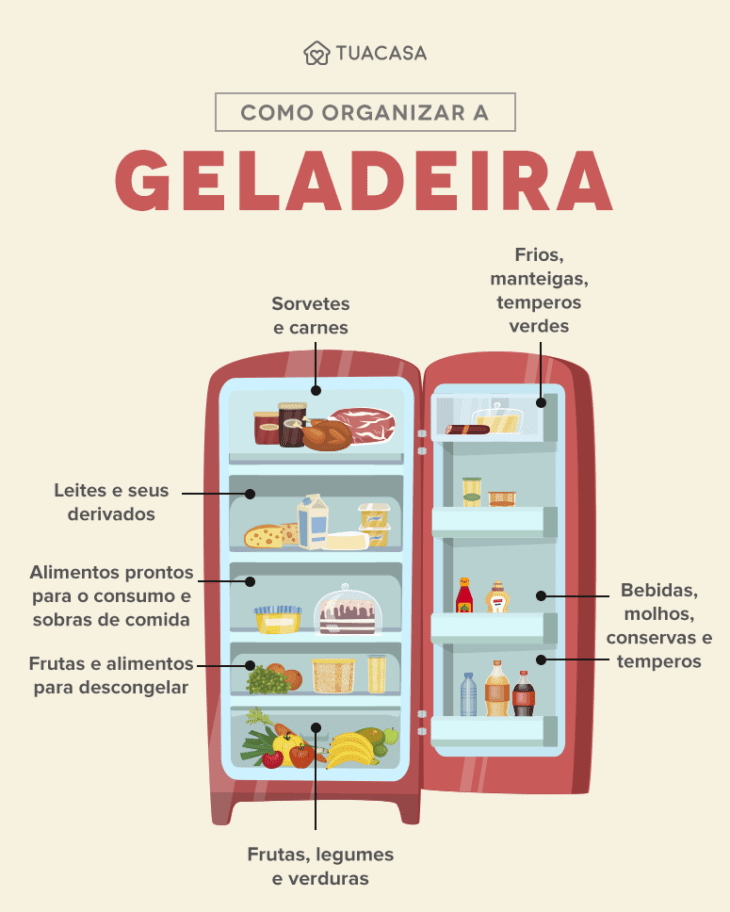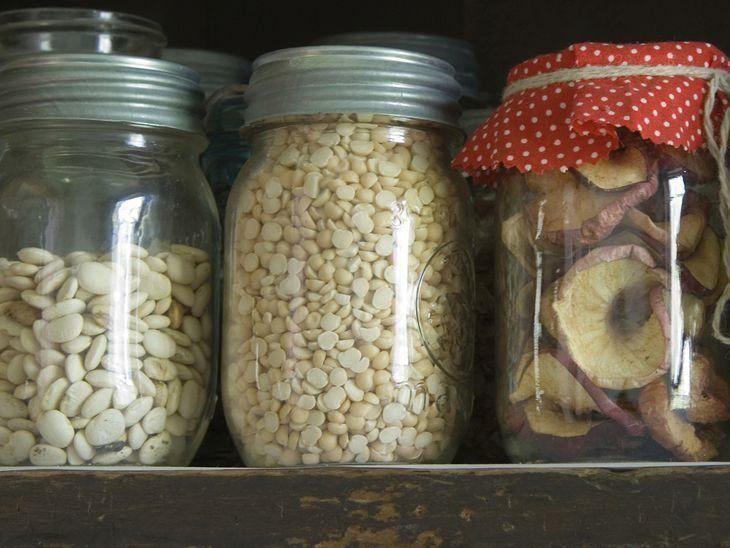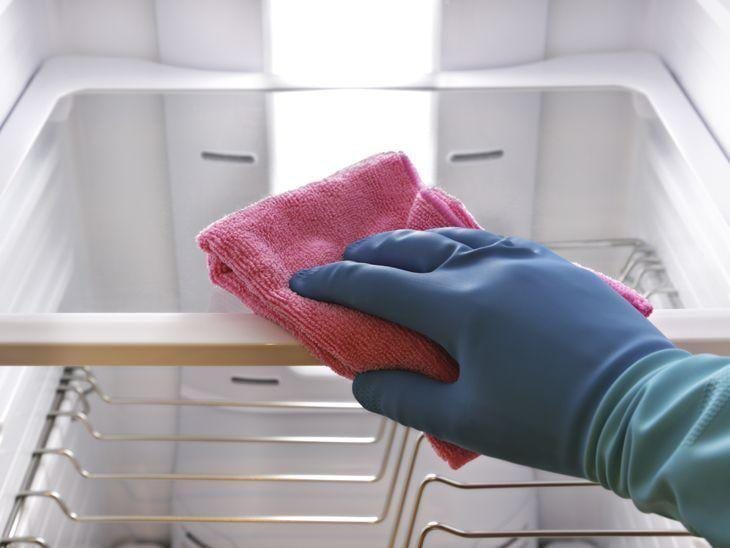Table of contents

Keeping the refrigerator organized is far from being a whim: when everything is clean, in sight, and in the right place, your day-to-day routine in the kitchen becomes more practical and you even avoid food waste.your refrigerator clean and organized.
How to keep food organized in the refrigerator
Each part of your refrigerator reaches a different temperature, already with the intention of better preserving certain foods according to where they are stored. In addition, "the ideal is to always keep the food well closed. Everything that is raw should be placed at the bottom, while what is ready for consumption and/or cooked should be placed on the top shelf,adds the nutritionist and franchise manager at VIP House Mais, Juliana Toledo.
Check out how to store food in each part of your refrigerator, starting from the bottom up:

Bottom drawer
It is the coldest part of the refrigerator, and the most appropriate for storing fruits, vegetables and greens, which are foods more sensitive to low temperatures and can even spoil. "Strawberries, raspberries and blackberries have a faster deterioration process, so these fruits should be kept in the coldest part of the refrigerator, inpackages with air inlet and outlet", advises Juliana Faria.
Last shelf/lowest drawer field
Both can be used to store fruits - the softer ones in trays and the harder ones in airtight bags. Food for defrosting also stays here.
Intermediate shelves
If you prepare food the day before to take to work the next day, this is also the place to keep closed plastic or glass jars with lids.
Tip from the personal organizer: "Opt for transparent jars or put labels on them so that they are easier to see and also so that you don't have the refrigerator door open for too long while you are looking for what to get."
Top shelf: The higher up in the refrigerator, the colder. Therefore, the top shelf is ideal for storing milk and milk products such as cheese, curd, yogurt, in well-sealed containers. If you like your drinks cold, this is the best place for soft drinks, juices or water. Unlike what is normally recommended by refrigerator manufacturers, the middle shelves orThe tops are also the best place to store eggs, so you avoid the constant jarring of the refrigerator opening and closing, and still keep them at the same temperature.
Tip from the personal organizer: "In this part, organize everything in ventilated trays, the food separated by type, and if there's a space left over, put together a breakfast basket with all the ingredients to go straight to the table."
See_also: Golden cake: 90 models to customize your party with styleTop drawer
If there is a top drawer just below the freezer, this is where you should keep the cold cuts, butters, green seasonings, such as parsley and chives, or fish and meat that will be prepared. The personal organizer recommends that the cold cuts and sausages be removed from the trays and placed in appropriate jars, separated by types.
Freezer
The freezer is the ideal place to store frozen foods or foods that need to be kept at a lower temperature, such as ice cream and meat, for example, but these foods can also spoil: "Use identification labels and add the date it was frozen. Organize them by category: meat, chicken, ready meals. Keep an inventory with all the foods and the date ofEach one's expiration date, so you don't run the risk of letting something go past its expiration date and spoil", instructs Juliana Faria.
Now, if you want to freeze that food left over during a family lunch, the goal is to ensure greater durability. Besides identifying what and when it was frozen with labels, make sure the jars are resistant to low temperatures. "Remember that once thawed, the food should not return to the freezer," reiterates nutritionist Juliana Toledo.
Door
The refrigerator door is the place that suffers the greatest temperature variation due to the constant daily opening and closing. Therefore, it is ideal for fast consumption processed foods such as drinks (if you don't like things too cold), sauces (ketchup and mustard), preserves (hearts of palm and olives), spices and food groups that don't suffer with temperature oscillation.products by category, distributing each one in a division.
See_also: Ivory color: 50 ideas to convince you to bet on this trend6 tricks for storing food in the refrigerator

Everyone stores food in the refrigerator the way they find most convenient for their lifestyle, but by following a few tips you can extend the shelf life of your food; you can also save space in the refrigerator without having to leave any items off your shopping list.
When it comes to organization, it is best to store cut or cooked food in square or rectangular jars, since they take up less space and can be easily stacked.
- Food washing: it is good to wash fruits, vegetables and legumes only at the time of consumption. After washing in running water, soak them in a solution of bleach and water (1 tablespoon for every 1 liter of water) for 10 to 15 minutes. Rinse with filtered water to avoid recontamination. Pass the vegetables in a centrifuge and put them in plastic jars with ventilation holes, interspersed with papertowel.
- Hygienization of packages: packages bought at the supermarket should also be washed, before being placed in the refrigerator. Wash with water and detergent, except those that are Tetra Pack. In these cases, just wipe them with a damp cloth. When everything is dry, it is time to store them in the refrigerator.
- Open food: products such as condensed milk and tomato sauce, when opened, should be taken out of their original packaging and placed in glass or plastic jars. "I recommend using film paper to avoid stains and also to protect from toxins. Identify everything with labels, containing information such as opening date and expiration date", says nutritionist Juliana Toledo. To avoid smells in the refrigerator,opt for acrylic trays to group food items such as those for breakfast, for example, which would include margarine, butter, cream cheese, cold cuts, milk and yogurts.Faria.
- Due Date: To avoid unnecessary loss of food, adopt a very useful little rule called PVPS - First Due, First Out. Leave the products that expire first in front and at eye level so that they don't get forgotten in the refrigerator.
- Fruit ripening: For dark apples, put them in a container with cold water and lemon juice. This will make them clear even after cutting them. That half of the avocado that is left over should be stored together with the core. The pineapple, on the other hand, once peeled, should be kept under refrigeration.
- Conservation tips: Cassava lasts much longer when peeled, washed and stored in the freezer in a plastic bag. Eggs can also be kept longer when stored with the pointed part down.
14 items that should not be put in the refrigerator

Have you ever stopped to think if everything you put inside the refrigerator really should be there? There are things that are normally refrigerated, but if they were kept at room temperature they could last longer or even retain their nutrients better. Check it out:
- Cans: should not be stored open, as they will rust. Remove the food from the can and keep it in a well-sealed jar before putting it in the refrigerator.
- Cloth or paper: should not be used to line the refrigerator's shelves, since they are washable. In addition, the lining impedes circulation, forcing the motor to work harder and consequently use more energy.
- Tomatoes: Although it is customary to put them in the refrigerator, this is not the best way to preserve tomatoes. Contrary to common sense, tomatoes should be placed in the fruit bowl upside down, thus maintaining their nutritional characteristics and natural flavor. The recommendation is to buy only what is necessary for the week, avoiding losses.
- Potatoes: Also contrary to common sense oriented practice, potatoes should be packed in paper bags and stored in the cupboard. When placed in the refrigerator, the starch is transformed into sugar and its texture and color are altered when the food is cooked.
- Onions: Onions need ventilation, so they should stay away from the refrigerator. There they suffer from humidity and will tend to soften. The best place is in the pantry, in the dark, in paper bags or wooden boxes. If there is a piece left over after cooking, butter the cut half and store it in the refrigerator in a closed container. This prevents it from drying out, but consume it soon. The sameThe same technique applies to hard cheeses.
- Garlic: Garlic can last up to two months outside the refrigerator, as long as it is kept in a cool, dry place. If refrigerated, it can lose its characteristic flavor, create mold due to lack of ventilation and humidity, and its texture can become soft and elastic. The ideal is to keep it in paper or newspaper bags, but with small holes for ventilation.
- Melon and Watermelon: it is proven that fruits like melon and watermelon are best kept out of the refrigerator. Being at room temperature keeps the nutritional characteristics, especially the antioxidant levels (Lycopene and Beta Carotene) intact. When cut, however, the ideal is to keep them under refrigeration wrapped in plastic film.
- Apples: Apples last for a long time at room temperature, reaching two to three weeks. The refrigerator should only be used if the idea is to store them even longer. They should be kept in the fruit bowl, away from the bananas to prevent them from ripening quickly, or in wooden boxes. A good idea is to store them together with potatoes to prevent the germination process.
- Basil: Avoid storing basil in the refrigerator. Low temperatures are not recommended. Wash, dry, cut the branches diagonally and store them in a glass of water, out of the sun, and covered with plastic wrap. Change the liquid every day or every other day.
- Oil or olive oil: store the oil and olive oil together with the wines, lying in a darker place at a mild temperature. When refrigerated, they become thick, cloudy and with a buttery aspect.
- Honey: Honey keeps itself naturally, so it doesn't need a refrigerator, even after it has been opened. Low temperatures can thicken and crystallize the sugars present in honey, changing the consistency of the product. Close the jar tightly and store it in the pantry or kitchen cabinet, preferably in the dark. Marmalades and jellies, however, should always be kept in the refrigerator,especially after opening.
- Coffee: Powdered coffee, contrary to what some people usually do, must be kept away from the refrigerator, in closed containers. When refrigerated, its flavor and aroma are altered, since it absorbs any smell that may be around.
- Bread: If the idea is just to preserve what will not be eaten within four days, the freezer is the best option.
- Canned peppers: closed or opened, the jar of canned chilis should stay out of the refrigerator. The shelf life of these products can reach up to three years, thanks to ingredients like vinegar and olive oil, which contribute to their preservation.
How to clean the refrigerator and avoid unwanted odors

It is recommended to clean the refrigerator every 10 days and the freezer every 15 days," adds nutritionist Juliana Toledo.
Then learn the best step-by-step approach to make your refrigerator brand new!
External cleaning
- Prepare a mixture with 500ml of water and 8 drops of colorless or coconut detergent and put it in a spray bottle;
- Swish the solution around the outside of the refrigerator;
- Remove the dirt with a damp cloth or microfiber cloth, and then wipe with a dry cloth so as not to stain;
- Unplug the refrigerator to remove dust from the back with a vacuum cleaner or a soft brush.
Internal cleaning
- With the refrigerator already turned off, look at the expiration date of the food. Transfer whatever is good to a cool box, Styrofoam, or bowl with ice, and discard whatever is needed;
- If you don't have a frost free, remember to defrost that layer of ice that lodges in the freezer;
- Removable parts such as drawers, shelves, and door dividers can be removed from the refrigerator and washed under running water;
- To clean, use a soft sponge and mild soap;
- With the mixture from the spray bottle, clean all the inside with the sponge and then a damp cloth;
- Also wipe a solution of baking soda and water on a multi-purpose cloth, without rinsing. This neutralizes the odor;
- Let it dry;
- Turn on the refrigerator and put everything away.
To complete the picture, the personal organizer Juliana Faria highlights the homemade charcoal trick, which is used to absorb unpleasant smells inside the refrigerator: "Place pieces of charcoal inside a glass or an uncovered pot to prevent contact with food.To prevent odors, the specialist recommends keeping the food stored in closed containers or sealed with plastic wrap.
Now that you know how to organize the refrigerator, how about more tips on how to organize the kitchen? Get the whole place in order!


